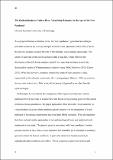The epidemiologist as culture hero : visualizing humanity in the age of “the next pandemic”
Abstract
Concern over the “coming plague,” a projected microbiological catastrophe threatening the survival of humanity, has come to generate a new cinematic figure: the epidemiologist as culture hero. The visual narrative of the “coming plague” unfolds in recent films, where the biopolitical content of this symbolic form becomes clear. This article examines how, by merging fears regarding the next pandemic with apocalyptic fantasy, the films in question institute the epidemiologist as responsible for the re-pastoralization and re-pasteurization of humanity—a goal achieved by setting self-limitation of individual freedoms as the condition for the biological and ontological perseverance of humankind.
Citation
Lynteris , C 2016 , ' The epidemiologist as culture hero : visualizing humanity in the age of “the next pandemic” ' , Visual Anthropology , vol. 29 , no. 1 , pp. 36-53 . https://doi.org/10.1080/08949468.2016.1108823
Publication
Visual Anthropology
Status
Peer reviewed
ISSN
0894-9468Type
Journal article
Description
Research leading to this paper was unded by a European Research Council Starting Grant (under the European Union's Seventh Framework Programme/ERC grant agreement no 336564)Collections
Items in the St Andrews Research Repository are protected by copyright, with all rights reserved, unless otherwise indicated.

